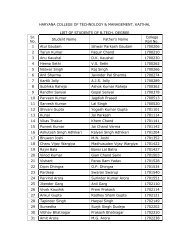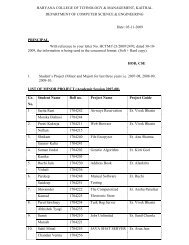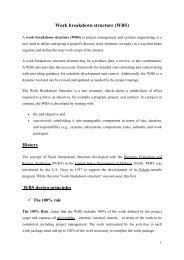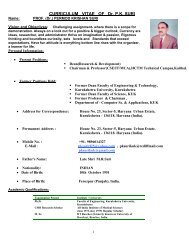You also want an ePaper? Increase the reach of your titles
YUMPU automatically turns print PDFs into web optimized ePapers that Google loves.
LECTURE NOTES OF ADVANCED DATA STRUCTURE (MT-CSE 110)<br />
(Van Wyk, Christopher J. <strong>Data</strong> <strong>Structure</strong>s and C Programs, Addison‐Wesley,<br />
1988, p. 175. ISBN 978‐0‐201‐16116‐8.)<br />
A threaded binary tree makes it possible to traverse the values in the binary<br />
tree via a linear traversal that is more rapid than a recursive in‐order traversal.<br />
It is also possible to discover the parent of a node from a threaded binary tree,<br />
without explicit use of parent pointers or a stack, albeit slowly. This can be<br />
useful where stack space is limited, or where a stack of parent pointers is<br />
unavailable (for finding the parent pointer via DFS).<br />
This is possible, because if a node (k) has a right child (m) then m's left pointer<br />
must be either a child, or a thread back to k. In the case of a left child, that left<br />
child must also have a left child or a thread back to k, and so we can follow m's<br />
left children until we find a thread, pointing back to k. The situation is similar for<br />
when m is the left child of k<br />
Multiway Search Trees<br />
A multiway search tree is one with nodes that have two or more children.<br />
Within each node is stored a given key, which is associated to an item we wish<br />
to access through the structure.<br />
Given this definition, a binary search tree is a multiway search tree.<br />
More Formal Definition<br />
Let T be a multiway search tree, then T has the following properties:<br />
• T is ordered, meaning that the all the elements in subtrees to the left of<br />
an item are less than the item itself, and all the elements in subtrees to<br />
the right of an item are greater.<br />
• Each internal node of T has at least 2 children.<br />
• Each d‐node (node with d children) v of T, with children v1,...,vd stores d‐1<br />
items (k1, x1),...,(kd‐1, xd‐1). Where the ki's are keys and xi is the element<br />
associated with key number i.<br />
Prepared By :<br />
Er. Harvinder Singh<br />
Assist Prof., CSE, H.C.T.M (Kaithal) Page ‐ 207 ‐







